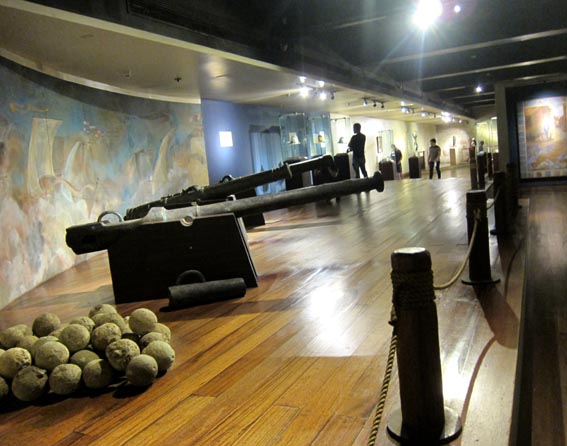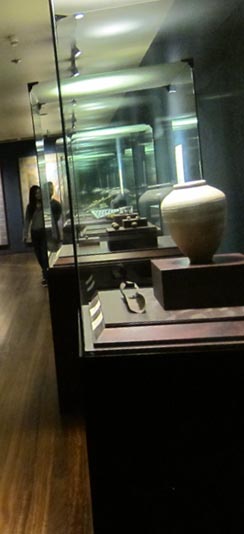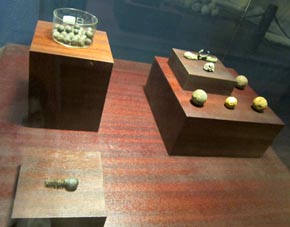一枚の特選フォト⌈海 & 船⌋
One Selected Photo "Oceans & Ships"
Back to: Top Page |
サンディエゴ号沈船 (その4)/道具類、武器・銃砲弾類
[フィリピン国立民族学博物館]
1 2
2
3 画像左上: マスケット銃や火縄銃の鉛弾 Lead balls for muskets and harquebuses 画像左下: バネのついた弾丸/鉛、真鍮または鉄線: 爆発力でワイヤーは解け伸び広がっている。その弾丸の目的は敵の船の帆と支索などの 艤装とを引き裂くことであった。 Spring shot/lead, brass or iron wire: The wire uncoils and spreads out as a result of the force of the explosions. Their probable purpose was to rip apart the sails and rigging of the enemy of the ships because they span as they flew through the air. |
|
1600年12月のある日のこと、スペインのガレオン船サンディエゴ号はオランダの海賊船モーリシャス号とマニラ近海で戦闘となった。
そして、サンディエゴ号はマニラ湾外のフォーテュン島(Fortune Island)沖1.4kmで、1600年12月14日午後3時頃に沈没の憂き目に合った。
フィリピン国立民族学博物館には、沈船サンディエゴ号から引き揚げられた航海器具、道具類、武器や銃砲弾類が展示される。
画像 1~3 は、サンディエゴ号から引き揚げられた遺物の中から発見された銃砲弾類である。大砲(画像1)も展示されているが、
キャプションがないので、同号から引き揚げられたものかどうかは不詳である。 展示パネルには次のように記される。 I. 海水はサンディエゴ号の船内の有機性の物体の大半を悪化させた。他方、金属製の物は凝固した形状によってのみ判別された。 発見された金属製の物としては、恐らく武器保管庫を安全に戸締りするために用いられた大型の南京錠(pad lock)、その他としては ハンマーである。また、恐らく艦長室で使われた木製のフレームを有するガラス皿である。 II. 士官室は木製の家具が備え付けられていた。装飾はほとんどが木製であるが、取っ手には金属製の装飾品が取り付けられていた。 錠前はさまざまなシー・チェスト(sea chests; 乗組員が私的な小物を入れておく箱)でも使われた。
Tools from the San Diego I/サンディエゴ号から引き揚げられた道具類 I
武器類について下記のように記される。
"Weapon Which Could Not Withstand the Pasage of Time" 時間の経過に堪えれなかった武器
Nevertheless, centuries under water have destroyed most of the ship's weaponry. The defensive equipment - helmets, backplates, breastplates and coats of mail - survives only in the form of a few severely corroded fragments, while even less remains of the offensive weapons - harquebuses, muskets and swords. All that has been found are a few accessories such as pins, buckles, hangers and medallions, which in themselves prove that the ship carried a large contingent of armed men.
"The Weaponry of the San Diego" サンディエゴ号の武器について
The cannons were fabricated in the Philippines, Flanders and Portugal. There were 8 grades of caliber which required different types of munition. The iron cannon balls were for the smaller cannons and the stone cannon balls for the bigger ones. The cannon balls weighed between one and seven kilograms. The cannons from Portugal were more advanced and were called breech loaders. A glimpse of the soldier's outfits came from pieces of armour, belts, and shoe buckles recovered, as well as swords and muskets. In addition, a ball mould to press musket and arquebus balls was found. A pair of Japanese swords and two dozen sword decorative elements point to the possibility of high ranking Samurais on board, probably mercenaries. 1. [拡大画像: x28168.jpg] 2. [拡大画像: x28169.jpg] 3. [拡大画像: x28195.jpg] |
Back to: Top Page |